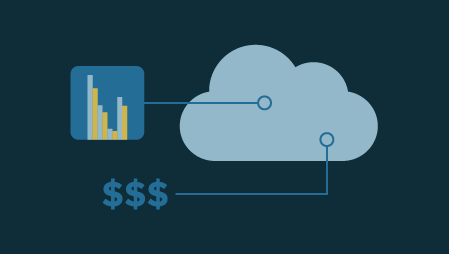Cloud computing is the anytime, anywhere delivery of IT services like compute, storage, networking, and application software over the internet to end-users. The underlying physical resources, as well as processes, are masked to the end-user, who accesses only the files and apps they want.
Companies (usually) pay for only the cloud computing services they use, making it an excellent solution for businesses looking to:
- Streamline IT processes
- Scale their operations
- Speed up their workflows
- Lower operational costs
Over the past decade, the cloud has replaced workstations with a hardware-software combination in corporate IT networks as the default solution for big and small businesses alike. According to a study by O’Reilly, 88% of companies now use the cloud in one form or another. What’s more, the overwhelming majority of them plan to move more of their workloads to the cloud in the next year.
That said, cloud computing models come with their fair share of complexities and myths. So, learning how to choose, implement, manage, and navigate the right solution is necessary in order to meet the business objectives behind your cloud migration.
1. Choose The Right Deployment Model
There are three major cloud deployment models: public, private, and hybrid. Without knowing the intricacies and benefits of these different architectures, you won’t be able to deploy the ideal environment that works best for your organization. Let’s take a quick look at the basics:
Public cloud:
Most office productivity applications across different business functions are now available on SaaS platforms provided by the behemoths Microsoft (Azure), Google (Google Cloud), and Amazon (AWS).
These public cloud plans come in t-shirt type packages for companies with varying requirements, which enables you to get started quickly with applications that scale with your business. Data is created and stored on the public cloud provider’s server, so you have no need to buy, maintain, or upgrade hardware resources. Thus, the public cloud is ideal for startups and small businesses that can’t invest a lot of capital upfront in technology infrastructure.
Private cloud:
Private cloud models minimize security risks because the underlying infrastructure is solely owned by one company, and only a select pool of individuals get access to the data stored in its repository. This is ideal for companies that operate in industries that need a high level of regulatory compliance – such as health, finance, and telecom – when it comes to data and privacy.
Regardless of the data centre’s geographic location, you (or your managed service provider) control the hardware and software configuration.
Hybrid cloud:
A hybrid cloud environment provides the best of both worlds, as you can pick and choose the features from private or public models and create a combination that best meets the needs of your business. With this option, you benefit from more robust privacy and security for business-critical applications, while saving costs and adding flexibility for routine workloads.
Naturally, a hybrid cloud system is more complex to implement, and there are various challenges in deploying it.
Community cloud:
The “community cloud” is an extension of the private model; it has a “multi-tenancy” structure where the infrastructure is shared by multiple group companies or subsidiaries of the same parent organization. As a result, they get the security and customizability of private clouds with the flexibility and cost scalability of public clouds.
Multicloud:
Another concept is a “multi-cloud,” which is a collection of multiple cloud systems (usually public) from different vendors working together under a single architecture. If it involved multiple public as well as private clouds, it would fall under the hybrid category. A simple example is an enterprise that uses separate providers for SaaS, PaaS, and IaaS services. It can also be taken to mean an architecture with cloud-native applications that use component services from different cloud providers.
Whatever flavour of cloud you finalize, make sure you automate your cloud infrastructure with the right tools in order to complete a swift migration and face minimal obstacles in configuration or operations.
2. Strategize for Business Growth
Picking a suitable deployment model will only take you so far. Nearly 60% of respondents to the Flexera State of the Cloud survey categorized themselves as “advanced” users of cloud systems, with heavy usage of cloud apps.
This makes it more likely than not that your organization is well past the beginner level with cloud usage. This means you need to look for ways to use more cloud apps and move more operations to the cloud without breaking the bank. While small businesses can probably get started with a simple pay-as-you-go subscriber service – Google Workspace being one of the most common examples – they will soon need to consider more complex cloud architectures, especially when they go beyond SaaS to PaaS and IaaS.
As your business grows, you need a decision framework to meet your unique needs. You must make sure that all the departments (and not just IT) understand why certain apps run in the cloud, and why your platforms and services have been deployed the way they are. For this, you need an effective cloud management strategy, which allows for continuous delivery, workflow automation, and observability.
Most notably, you’ll want to create a system that tracks the performance of your workloads, minimizes the need for human intervention, and enables unified management and easy administration of the whole cloud environment. Some of the biggest advantages of having an effective cloud management strategy in place are:
Cost savings: When you choose a private, public, or hybrid cloud, your strategy defines exactly what functionality you need, integrations with other software or external providers, and compliance for data storage or access. Armed with this information, you can negotiate better with cloud providers, and make sure you don’t over-provision for resources you don’t use. For instance, with private cloud workloads that peak in usage at predictable times, you can plan for “cloud bursts” – taking the additional data and application processing on to a public cloud for a specific duration.
Risk management and disaster recovery: Infrastructure downtime is as unavoidable as death and taxes. Your cloud computing strategy should define processes for instant switchover or incident response in the event of a hardware failure or a security breach. Again, you can spread your services over private and public clouds, with the former handling sensitive data and the latter being used for archives.
Mitigating vendor lock-in: Contrary to popular perception, vendor lock-in for cloud systems isn’t unavoidable. With a smart cloud strategy, you can plan for functionality, security, agility, and portability without fully committing to an architecture from a single vendor and using open source technology where sufficient.
Centralized management: The hallmark of true IT infrastructure management is the unification of different environments and legacy hardware and software with today’s cloud-based applications. Make sure you implement a cloud management platform that allows for “single pane of glass” management, i.e., the provisioning (allocation) and deprovisioning of compute, storage, and network resources transparently across your entire application and database stacks.
When you don’t have to worry about bloated costs or sudden disruptions to operations, you can focus on growing your business and increasing overall productivity.
3. Transform the Customer Experience
A study titled “Cloud-based Contact Center Market” by Research and Markets found that 39% of contact centers in the UK have moved to the cloud already, while as many as 57% are planning to move in the next three years.
The stats speak for themselves. If you’re wondering why the cloud is becoming the de facto IT infrastructure for businesses looking to improve their customer experience, here are some simple reasons:
- You can offer customers 24/7 access to your services and products. Most ecommerce websites can now scale for sustained transactions.
- You can offer multichannel customer support, all of which are integrated with your website. A simple example is the ubiquitous chatbot, which lets your audience connect to you from your website or a social network such as Facebook.
- Some features of cloud computing facilitate easy personalization of the shopping experience by collecting, processing, and analyzing big data in real time.
- Customers get an experience that is consistent with other places on the web because of the standardization of cloud technology and user interfaces across vendors such as Google and Amazon.
In conjunction with AI and martech tools, you can use the cloud to enhance the customer experience by making every interaction personalized, hyper-focused, and user-centric. These days, major cloud vendors and SaaS providers offer platforms and tools with which companies can build and scale chatbots with first-party data. A common example is Google’s Dialogflow:
The Silver Lining
Over the past decade and a half, cloud computing has slowly but surely become the dominant technology platform. This is reflected in its near-universal adoption because of the operational efficiencies, cost efficiencies, and competitive advantage that it offers.
While there’s an abundance of features and benefits, there are still barriers to cloud adoption including complexity, security, compliance, and control. However, if you know your cloud, then these are really silver linings, not disadvantages, once you’re on your way to full cloud adoption. The proof lies in the pudding – a Salesforce study reported that 94% of businesses saw an improvement in security after switching to the cloud, and 91% found it easier to meet government compliance requirements.
By choosing the right cloud deployment model, implementing a well-thought out strategy, leveraging tech talent, and keeping your focus on your customers, you can scale your business, streamline operations, and increase profit margins with minimal fuss. Growth, anyone?





